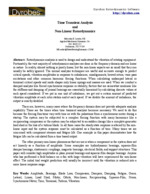Papers
“Time Transient Analysis and Non-Linear Rotordynamics,” |
Abstract:
Rotordynamics analysis is used to design and understand the vibration of rotating equipment. Fortunately, the vast majority of rotordynamics analyses are done in the frequency domain and are linear in nature. In reality, almost nothing is purely linear, but the non-linear aspects are so small that they can usually be safely ignored. The normal analysis techniques are useful and accurate enough to predict critical speeds, vibration amplitudes in response to imbalances, misalignments, bowed rotors, vane-pass excitations and other common harmonic forcing functions. When calculating undamped lateral or torsional critical speeds and mode shapes only linear springs and masses are used. When we conduct a damped analysis like forced synchronous response or stability, factors that are somewhat nonlinear like the stiffness and damping of journal bearings are essentially linearized by calculating discrete values at each speed considered. If we put in one unit of imbalance, we get out a certain amount of predicted vibration amplitude at each rotor station and at each speed. If we double the amount of imbalance, the output is exactly doubled.
There are, however, many cases where the frequency domain does not provide adequate analysis capability. These are the times when time transient analysis becomes necessary. We need to do this because the forcing functions vary with time as with the pulsations from a synchronous motor during a startup. The system may be subjected to a complex forcing function with many harmonics like a reciprocating compressor or the system may be subjected to an sudden change like a complete generator load shed or the loss of a turbine blade. In all these cases the steady state response is altered by the non- linear input and the system response must be calculated as a function of time. Many times we are concerned with component stresses and fatigue life. One example in this paper demonstrates how the fatigue life can be calculated from a time based output.
The other primary non-linear phenomena that occurs is when a component in the system does not act linearly as a function of amplitude. Some examples are hydrodynamic bearings, squeeze-film damper bearings, elastomeric couplings, magnetic bearings, electrical fields, and support structures. This paper will consider high amplitudes in plain journal bearings and squeeze-film damper bearings. Anyone who has performed a field balance on a fan with large vibration will have experienced the non-linear effect. The initial trial weight prediction will usually be incorrect until the vibration is reduced into a more linear response range.
Keywords:
Amplitude, Bearings, Blade Loss, Compressor, Dampers, Damping, Fatigue, Gears, Lateral, Linear, Load Shed, Motor, Orbits, Non-linear, Reciprocating, Squeeze-Film, Stress, Synchronous Motor, Time, Torsional, Turbine, Vibration

